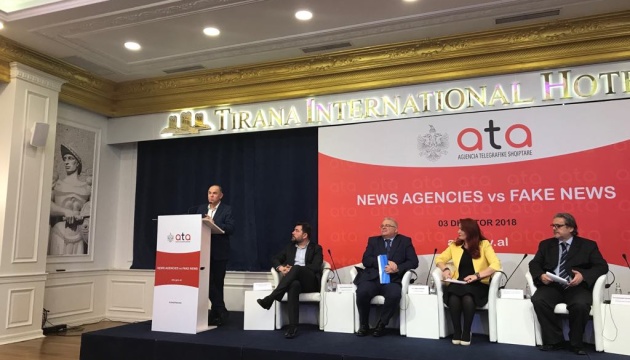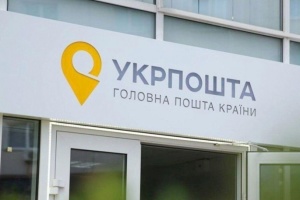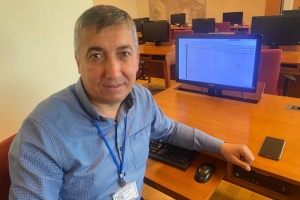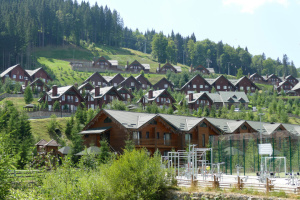
Fake news: accepting the challenge
On December 3, Tirana hosted an international conference "News Agencies vs Fake News" organized by the Albanian Telegraphic Agency (ATA). The event was attended by representatives of 14 news agencies from different countries of Europe, including Ukrinform from Ukraine. We offer the text of a speech at the conference by Ukrinform Director General Oleksandr Kharchenko:
If you once happen to a bar in Ukraine and you occasionally hear a veteran of war casually telling someone “So where are my two slaves?”, don’t get scared. There are no slaves. The veteran is simply referring to a notorious fake story by Russian propaganda saying that the Ukrainian government is motivating soldiers to fight at the frontline by promising them “a piece of land and two slaves” upon their return. The story was so outrageous that it later transformed into a joke in Ukraine. Actually, one of the effective defense mechanisms against propaganda is a good laughter.
However, not all fake news are as surreal. Some are much more sophisticated, difficult to detect and thus posing higher threats.
In today’s speech I would like to focus on a few things. First of all, on some of the typical examples of fake news that we encountered in Ukraine in recent years and their methods. Secondly, on deeper causes making societies vulnerable to fake news and disinformation. Thirdly, on what can be done by news agencies around the world to overcome challenges posed by fake news.
THE ONE WHO WAS WARNED IS THE ONE WHO WAS ARMED. This proverb emerged much earlier than our modern “fake news” term. It is truly important to remember that fake news are as effective as uncritical their consumer is. The one aware that he or she can be manipulated is much safer and less likely to get influenced. Raising awareness is therefore one of the most effective ways to tackle fake news.
Were we warned in Ukraine? Were we aware? Probably, no. Very few could expect the height of the wave of fakes that Ukraine had to face in 2014. The fake tsunami took us by surprise. Paradoxically enough, we managed to deal with it and the experience accumulated can now be valuable to others.
NOTHING IS REALLY NEW ABOUT FAKE NEWS. Disinformation, especially as a part of a military strategy, is surely nothing new to this world. It has been effectively used by warring parties throughout centuries. If we take the current Russian disinformation, for instance, it is using mostly the good-old methods of the Soviet propaganda, including concepts of reflective control, subversion, active measures and other, more modern methods like weaponization of information. What has changed then? In my view, there emerged a political will to use those methods at their full scale. Additionally, modern means of mass communication enabled new effectiveness with even less effort.
What are examples of fake news that we’ve seen in Ukraine? Oh, full list would take hours to read. The count is at thousands of fake stories, which is proven by archives of the famous “StopFake”. Obviously, fake news belong to different actors and different states. However, what we’ve encountered in Ukraine is primarily Russian state propaganda, that is why I will largely focus on its examples today.
WHAT SHOULD WE KNOW ABOUT RUSSIAN DUCKS? As one famous joke goes, “If it walks like a duck and quacks like a duck, it is probably... a duck. If it walks like a duck, quacks like a duck and denies it’s a duck - that’s a Russian duck”. Putin’s Russia is known for its denialism, including denying producing fakes.
Russian propaganda mainly follows the 4-D rule: dismiss, distort, distract, dismay. I would like to provide you with one good example of the “distort” and “distract” strategies combined.
This case is Russia covering up its downing of a passenger jet over occupied Eastern Ukraine in July 2014. The Malaysia Airlines flight MH17 was shot down from the sky by a Russian missile, killing all 298 people on board. Immediately after the tragedy, to hide the trace of evidence which was very directly pointing at the Kremlin, the Russian state media did not simply refute Moscow’s responsibility. Instead, it began to simultaneously promote a number of made-up stories, one more surreal than the other. One story said the aircraft was filled with dead bodies before departure and crushed over Eastern Ukraine to deliberately blame Russia. The other told that the aircraft of Russian President Putin was flying somewhere near the place of incident and had been the real target. One more insisted that it was a Ukrainian jet that fired an air-to-air missile at the passenger airliner.
No, it did not make too many people believe each one of those falsehoods alone. But it created a very mixed general picture, in which real facts became blurred to many other “alternative” versions of events. As a result, although in the very first day of the incident Ukraine said (and presented evidence) that the airliner was shot down from the sky by a Russian BUK-M1 missile complex, it was taken very cautiously in the international community. “Other” versions, however surreal and false they might have been, created a false impression of “many sides” to the story and that everything is not that clear. “Question more!” says the slogan of “Russia Today”. Does it really mean “Nothing is true?” Let’s have a look at what are the deeper causes of such behavior of Russians.
LYING IS CREATIVE. The current political paradigm of the Moscow’s regime is what can be called “Everything is possible and nothing is true” - there is such book by brilliant Peter Pomerantsev. The phrase was crafted by one of ideologists of putinism, Vladislav Surkov. What it means is that facts do not matter anymore, and it’s all about constructed realities. Any event or fact is what it is presented and not what it is. This strategy erodes truth and creates basis for whataboutism.
Erosion of truth is actually one of the reasons why Russian propaganda has lost part of its effectiveness lately. Japanese futurologist Michio Kaku is famous for illustrating this phenomena with two encephalographic images: one brain scan marked with all colors possible, all zones working intensely, and the other one in plain color and not show much activity. The second one, Dr. Kaku explains, is a brain of a person who tells truth. The first one, coloured and intensively working, is a brain that lies. Lying requires creativeness. A good lie is constructed in three steps. First: know the truth. Second: create a lie. Third: check how good is your lie by applying it to the truth and making sure it won’t be exposed. Therefore, by eroding truth to the current extent, authors of Russian propaganda might have lost the first necessary precondition for creating a masterful lie - own knowledge of the truth. But let’s look at another notorious example of the Russian propaganda.
NOTHING IS TRUE AND EVERYTHING IS POSSIBLE, ESPECIALLY WHEN ACTORS HELP PRODUCE TV REPORTS. Russian propaganda is known for not shying off from hiring actors to pose as witnesses or scripting false stories for the interviewed. This was the case with the famous “crucified boy of Sloviansk”. At that point Ukrainian army has just regained control over a strategic town in the Eastern Ukraine, Sloviansk, where the whole war began in spring 2014. Russian main state TV channel, “Rossiya-1” has aired a report, which contained an interview with an alleged displaced person who flew from atrocities of the Ukrainian army. Without slightest hesitation, the women described a scene she allegedly saw at the central square of the town after Ukrainian forces took it: “They brought all people to the central square to conduct what they call “a public execution”. They took a little boy, just three years old, and nailed him to the bulletin board, just as if he was Jesus. One man was hitting the nails, two others were holding the boy. His mother had to watch it all. Some people lost consciousness”. Of course, the boy is a resident of the same country that two slaves live in. This land is called “imaginary world of Russian propaganda”. The described event had never happened. The same strategy was applied with the propagandistic story published in Kremlin-friendly Italian media on “Georgian snipers” on Maidan. The Italian film of 2017 shows real people who confess in interviews that they were snipers who shot at both protesters and police during protests in Kyiv in winter 2013-2014. The story creates a false narrative that it was not riot police that shot them (which was what really happened), but rather some “third force”, some mysterious snipers, who created a false-flag operation to overthrow the government. The story is also a fake, and “Georgian snipers” are most likely actors, as debunked later by the “StopFake”.
However, the problem is broader than simply Russian fake news. By the way, not only Russian ones. There are Ukrainian fakes as well. This is what we love “StopFake” for: they are filtering all disinformation, regardless of the source. At their website, false stories of Ukrainian origin can also be found. However, it is worth noting that neither by scale, nor by arrogance do Russian falsehoods have any remotely close competitors.
WHAT MAKES FAKE NEWS SO POPULAR? One important point of both cases I have just mentioned - of the crucified boy and MH17, is that both use strong emotions in order to unlock the audience’s minds. Once a strong emotion is triggered, critical thinking switches off and then anything can be brought in around defenses. The more ridiculous and surreal the trigger, the better, it seems.
The wider problem is what enables falsehoods to spread so easily. The key is the modern media environment, especially the impact of social networks. In a world, where threads are customized and each one of us reads a personal newsfeed, filtered to have only what we want to read and avoid what we don’t, there seems to be no common basis - just competing narratives. Customized newsfeeds lead us to the state where societies are hugely polarized. Each one reads people whom he or she agrees with, and each one lives in own reality.
THE TRUTH IS SOMEWHERE IN THE MIDDLE… OF KISELIOV’S BRAIN. We’ve just talked about the world where what is true and what is not is more difficult for many to say than it had been before. Rogue actors like Russia, Iran and North Korea perfectly know how to use such state of affairs. Top Russian propagandist Dmitriy Kiseliov once said in an interview, “Truth is always somewhere in the middle”. Can this be serious? We know that truth is neither in the middle, nor to the right, nor to the left. The truth is simply in facts. If the truth is “in the middle”, as Dmitry Kiseliov says, then Russia can make its side so much stronger and louder, that the middle would eventually slide closer to the Russian point of view.
OKAY, OKAY, THAT’S ALL TOO BAD. BUT WHAT DO WE DO WITH THAT? As to means of combating the threatening influence of disinformation. There are some tools which have already been proven effective. However, we don’t yet have one ultimate way to limit the threat of fake news.
One thing is sure. When encountering any state propaganda, we as news agencies have a choice of three options:
Fully follow what propaganda says;
Totally opposing what propaganda says;
Totally ignoring what propaganda says
There is no fourth way of taking a bit of propaganda “for balance”.
What are the other effective methods? For instance, in Ukraine we have a regular monitoring of media conducted by the authoritative Institute of Mass Information (IMI). Specialists of the institute create ratings and anti-ratings of media based on analyzing random samples of their news, searching for misinformation, disinformation, fake news etc. in them. Such anti-ratings are very helpful because they motivate each media to care for their own reputation. We have to understand, that it is not always deliberate malign aim that stands behind fake news. Sometimes, they are being driven simply by sensationalism, clickbait headlines and chase for likes, clicks, audiences.
If we talk about the long-term impact, the most effective strategy is developing media literacy, critical thinking and media hygiene in the society. In Ukraine, for example, the ongoing reform of secondary education in Ukraine includes launching lessons of media literacy in secondary school since 2018. However, in the years 2014-2017, Ukraine had to make more radical and immediate steps, like simply banning Russian propaganda resources, kicking off air all Russian TV in 2014, banning Russian social networks in 2017. The measures were harshly criticized internationally and domestically and branded a limitation of the freedom of speech, but at the end of the day prohibitions proved effective in the short term. France has made similar but smaller restrictions, having barred Russian state propaganda channel “Russia Today” and propagandist news agency “Sputnik” from entry into the French parliament. This happened after their performance in the French 2017 elections, acting as agents of foreign influence rather than media. Again we see that only those who suffer directly tend to make conclusions.
Apart from the combination of long-term strategies and short-term decisions which can prove effective, some technological solutions to the way how users receive news can also significantly lower the threat of disinformation. We are currently working on developing some of such solutions in the agency.
As one clever proverb says, “You can’t do everything, but that is not the reason to not do anything”.




